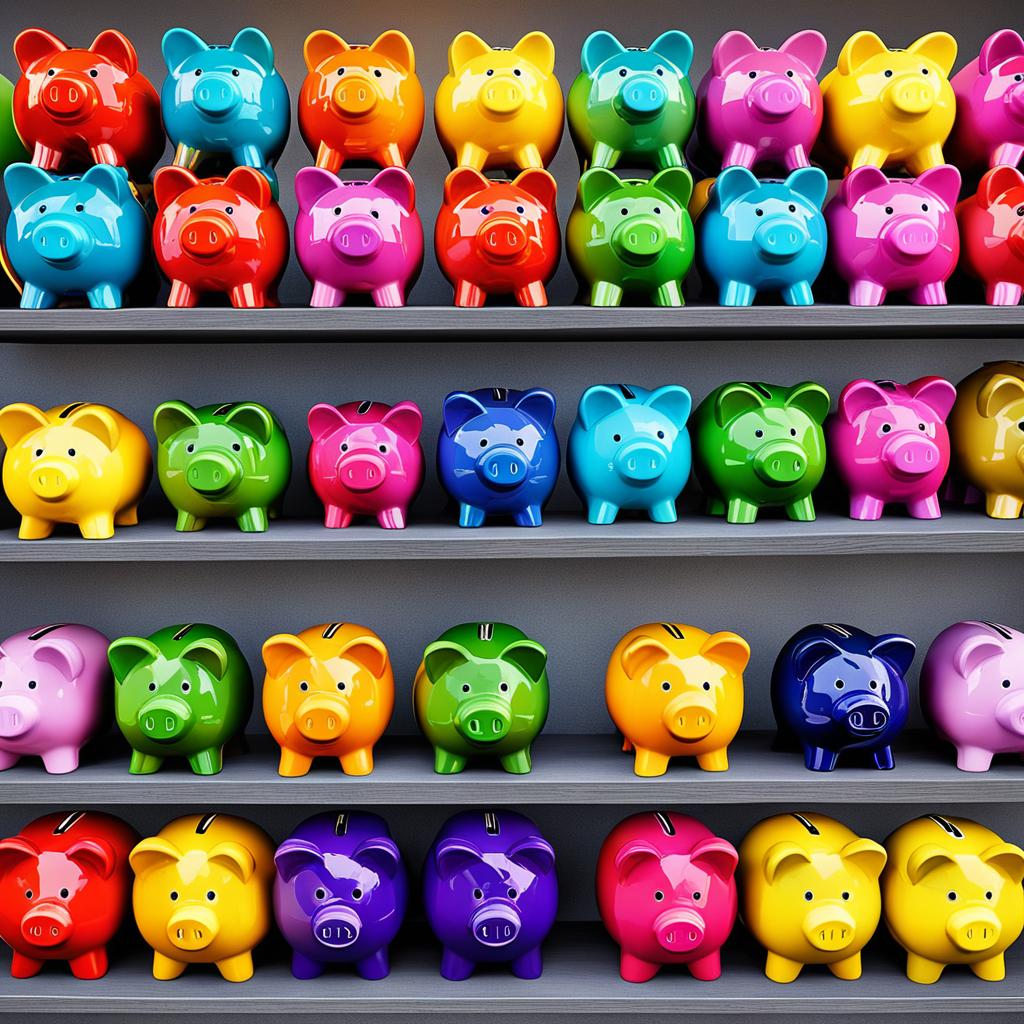A high-yield savings account is a great way to make your money work harder for you. With interest rates that far exceed the national average, these accounts offer an opportunity to grow your balance faster without any extra effort. Currently, the best high-yield savings accounts earn around 5% APY, compared to the national average rate of 0.46% APY.
Key Takeaways:
- High-yield savings accounts earn interest rates much higher than regular savings accounts.
- These accounts can help you maximize your savings and achieve your financial goals faster.
- Consider factors such as interest rates, fees, and minimum balance requirements when choosing an account.
- Online banks and smaller institutions often offer competitive rates and lower deposit requirements.
- Make sure to weigh the pros and cons before opening a high-yield savings account.
What is a High-Yield Savings Account?
A high-yield savings account is a type of savings account that offers a higher interest rate compared to a regular savings account. It allows your money to grow at a faster pace, giving you the opportunity to maximize your savings. With some accounts currently offering around 5% APY, a high-yield savings account can provide a significant boost to your financial goals.
Unlike traditional savings accounts that may earn minimal interest, a high-yield savings account offers a more attractive rate of return on your deposits. This means that the money you save will accumulate interest at a higher rate, helping you reach your financial milestones sooner.
High-yield savings accounts are typically offered by banks, credit unions, and online financial institutions. They provide a safe and secure way to store your money while giving you the opportunity to earn more in interest.
Whether you’re saving for a specific goal like a down payment on a house or building an emergency fund, a high-yield savings account can be a valuable tool in your financial arsenal.
Benefits of a High-Yield Savings Account
There are several benefits to having a high-yield savings account:
- Higher Interest Rates: High-yield savings accounts offer significantly higher interest rates compared to regular savings accounts. This means that your money grows faster, allowing you to reach your financial goals more quickly.
- Safe and Secure: High-yield savings accounts are typically federally insured, providing protection for your deposited funds. This gives you peace of mind knowing that your money is safe and accessible.
- Liquidity: High-yield savings accounts are highly liquid, meaning you can access your funds whenever you need them. This makes it an ideal option for emergency savings or short-term financial needs.
Opening a high-yield savings account is a simple and straightforward process. You can typically apply online, provide the necessary documentation, and make an initial deposit to get started. Many financial institutions offer user-friendly online platforms, making it convenient to manage your account and track your savings progress.
In the next section, we will explore why choosing a high-yield savings account is a smart financial move and how it can help you achieve your savings goals.
Why Choose a High-Yield Savings Account?
A high-yield savings account is a smart choice because it allows your balance to grow faster without any additional effort on your part. The higher interest rate means that your money is working harder for you, helping you achieve your savings goals more quickly.
When you choose a high-yield savings account, you can take advantage of attractive interest rates that are significantly higher than those offered by traditional savings accounts. This means that your money will earn more over time, enabling you to build your savings faster and reach your financial goals sooner.
By selecting a high-yield savings account, you can also enjoy the peace of mind that comes with federal insurance. These accounts are typically backed by the Federal Deposit Insurance Corporation (FDIC) or the National Credit Union Administration (NCUA), which means that your deposits are protected up to $250,000 per depositor, per institution. This ensures that your hard-earned money is safe and secure.
Benefits of a High-Yield Savings Account
Here are some key benefits of choosing a high-yield savings account:
- Higher interest rates: High-yield savings accounts offer significantly higher interest rates compared to traditional savings accounts. This means that your money grows faster and you can maximize your savings potential.
- Easy accessibility: Many high-yield savings accounts can be easily managed online, providing convenience and the ability to access your funds whenever you need them.
- Flexible deposit options: Most high-yield savings accounts have low or no minimum balance requirements, allowing you to start saving with whatever amount you have available.
- Federal insurance: High-yield savings accounts are typically insured by the FDIC or NCUA, providing protection for your deposits in case of bank failure.
Choosing a high-yield savings account can be a prudent financial decision. The combination of higher interest rates, easy accessibility, flexible deposit options, and federal insurance make it an appealing option for individuals looking to grow their savings efficiently.
Whether you are saving for a down payment on a home, an emergency fund, or a future vacation, a high-yield savings account can help you reach your goals faster and with less effort. It’s important to compare different account options, consider the associated fees, and choose a reputable financial institution that aligns with your preferences.
| Benefits of High-Yield Savings Account | Drawbacks of High-Yield Savings Account |
|---|---|
| Higher interest rates | Potential account fees |
| Easy online accessibility | Limited face-to-face customer service |
| Flexible deposit options | Higher minimum balance requirements |
| Federal insurance protection |
Difference Between High-Yield Savings Account and Traditional Savings Account
When it comes to choosing the right savings account, understanding the differences between a high-yield savings account and a traditional savings account is crucial. The main differentiating factor lies in the interest rates offered by these accounts.
Traditional savings accounts typically offer very low interest rates, sometimes as low as 0.01% APY. This means that the growth of your savings over time may be minimal. On the other hand, high-yield savings accounts offer significantly higher interest rates, with some currently earning around 5% APY. This substantial difference in interest rates makes high-yield savings accounts the preferable choice for individuals looking to grow their savings more effectively.
Comparing Interest Rates
A higher interest rate translates into faster growth of your savings. With a high-yield savings account, your money can work harder for you, allowing you to reach your financial goals more quickly. In contrast, traditional savings accounts may not provide the same level of growth due to their lower interest rates.
Quote: “The main difference between a high-yield savings account and a traditional savings account is the interest rate.”
Affordability and Accessibility
One advantage of both high-yield and traditional savings accounts is their affordability and accessibility. These accounts can usually be opened with a relatively low minimum deposit, making them accessible to a wide range of individuals. They also typically offer the convenience of online banking, allowing you to manage your account from the comfort of your home or on-the-go.
Consider Your Savings Goals
When deciding between a high-yield savings account and a traditional savings account, it’s important to consider your specific savings goals. If you’re looking to maximize the growth of your savings and earn a higher return on your investment, a high-yield savings account may be the better choice. However, if you prioritize accessibility and convenience over higher interest rates, a traditional savings account might better suit your needs.
Ultimately, the decision between a high-yield savings account and a traditional savings account depends on your financial objectives and risk tolerance. Assessing your savings goals, considering interest rates, and weighing the benefits and drawbacks of each account type will help you make an informed decision that aligns with your financial priorities.
By understanding the key differences between high-yield savings accounts and traditional savings accounts, you can make a more informed choice that aligns with your financial goals and helps you grow your savings more effectively.
| High-Yield Savings Account | Traditional Savings Account |
|---|---|
| Offers high interest rates | Offers low interest rates |
| Provides faster growth of savings | Offers slower growth of savings |
| May have higher minimum deposit requirements | Lower minimum deposit requirements |
Alternatives to High-Yield Savings Accounts
While high-yield savings accounts are a popular choice for growing your savings, there are also other alternatives to consider. Some of these alternatives include money market accounts, certificate of deposits (CDs), and checking accounts.
Money Market Accounts
Money market accounts offer similar benefits to high-yield savings accounts. They generally provide higher interest rates than traditional savings accounts and may offer added features such as debit cards and checks. Money market accounts can be a good option if you want easy access to your funds while still earning a competitive interest rate.
Certificate of Deposits (CDs)
Certificate of deposits (CDs) typically offer higher interest rates than high-yield savings accounts. With a CD, you deposit a sum of money for a specific period of time, usually ranging from a few months to several years. During this time, the money is locked in and cannot be withdrawn without penalty. While CDs may offer higher returns, they require a longer commitment and may not be suitable if you need immediate access to your funds.
Checking Accounts
Checking accounts are primarily designed for everyday spending, but some may also offer interest on your balance. However, the interest rates on checking accounts are generally lower compared to high-yield savings accounts. If you frequently use your checking account for transactions and want the convenience of immediate access to your funds, a checking account could be a viable alternative.
“Money market accounts and certificate of deposits offer alternatives to high-yield savings accounts, providing options for those who value easy access, higher interest rates, or a combination of both.”
It’s important to carefully evaluate your financial goals and needs when considering alternatives to high-yield savings accounts. Each option comes with its own set of advantages and considerations, so be sure to compare the features and benefits before making a decision.
In the next section, I will discuss how to choose the best high-yield savings account for your needs.

How to Choose the Best High-Yield Savings Account
When it comes to selecting a high-yield savings account, it’s essential to carefully consider the interest rates and service charges associated with different options. By taking the time to evaluate these factors, you can find an account that aligns with your financial goals and maximizes your savings.
Interest Rates
One of the key factors to consider when choosing a high-yield savings account is the interest rate offered. Look for accounts that provide competitive rates, as this will determine how much your money can grow over time. Currently, some accounts offer rates as high as 5% APY, allowing your balance to grow significantly compared to traditional savings accounts with lower rates.
Service Charges
Another important consideration is the service charges associated with the high-yield savings account. Look for accounts that have low or no monthly fees, as this will help you avoid unnecessary expenses and ensure that your hard-earned savings are not eroded by charges. Prioritize accounts that offer transparent fee structures and clearly outline any potential charges.
It’s worth noting that some high-yield savings accounts may require a minimum balance to avoid service charges. Be sure to check the account requirements and choose one that aligns with your financial situation and ability to maintain the minimum balance.
Smaller Institutions and Online Banks
When exploring high-yield savings account options, don’t overlook smaller institutions and online banks. These financial institutions often offer competitive interest rates and lower deposit requirements compared to larger banks. Additionally, online banks may have lower operating costs, allowing them to pass on more favorable rates to their customers. Consider exploring options beyond the traditional brick-and-mortar banks to find the best high-yield savings account for your needs.
By carefully evaluating interest rates, service charges, and considering smaller institutions and online banks, you can choose the best high-yield savings account that suits your financial goals. Remember, the right account will help your savings grow faster and provide the peace of mind that comes with choosing a reputable financial institution.
Pros and Cons of High-Yield Savings Accounts
High-yield savings accounts offer numerous benefits that can help you grow your savings faster. However, it’s important to consider the drawbacks as well. Let’s take a closer look at the pros and cons of high-yield savings accounts.
Benefits of High-Yield Savings Accounts
- Higher Interest Rates: One of the biggest advantages of a high-yield savings account is the opportunity to earn a higher interest rate compared to traditional savings accounts. With interest rates as high as 5% APY, your money can grow significantly faster.
- Federal Insurance: High-yield savings accounts are federally insured up to $250,000 per depositor, providing peace of mind that your funds are protected even if the financial institution faces difficulties.
- Easy Online Access: Opening a high-yield savings account is a hassle-free process that can be done entirely online. This convenience allows you to manage your savings from the comfort of your own home.
- Good Customer Service: Many banks and financial institutions that offer high-yield savings accounts are known for their excellent customer service. You can rely on their support to address any queries or concerns you may have.
Drawbacks of High-Yield Savings Accounts
- Higher Minimum Opening Balances: Some high-yield savings accounts may require a higher minimum opening deposit compared to regular savings accounts. This can be a barrier for individuals with limited funds.
- Limited Face-to-Face Customer Service: If you opt for an online-only high-yield savings account, face-to-face customer service may not be available. While online support is often efficient, some individuals may prefer the option of in-person assistance.
Understanding the benefits and drawbacks of high-yield savings accounts is essential in making an informed decision about where to park your savings. While the higher interest rates and federal insurance make these accounts an attractive option, it’s crucial to consider factors such as minimum balances and customer service preferences. By analyzing these pros and cons, you can choose the best high-yield savings account that aligns with your financial goals and needs.
| Benefits of High-Yield Savings Accounts | Drawbacks of High-Yield Savings Accounts |
|---|---|
| Higher Interest Rates | Higher Minimum Opening Balances |
| Federal Insurance | Limited Face-to-Face Customer Service |
| Easy Online Access | |
| Good Customer Service |
How Much Interest Can You Earn on a High-Yield Savings Account?
When it comes to high-yield savings accounts, the potential for interest earnings is one of the most appealing aspects. The amount of interest you can earn on a high-yield savings account depends on two key factors: your account balance and the interest rate.
Let’s consider an example to understand the impact of these factors. Suppose you have a high-yield savings account with a 5% annual percentage yield (APY) and a balance of $10,000.
“With a 5% APY and a $10,000 balance, you can earn over $500 in interest after a year.”
This means that over the course of a year, your high-yield savings account could generate more than $500 in interest. Compare this to a regular savings account with a lower APY of 0.40%, which would only earn around $40 in a year under the same circumstances.
By choosing a high-yield savings account with a competitive interest rate and maintaining a higher balance, you have the potential to significantly increase your interest earnings and accelerate your financial growth.

Now that you understand the potential for interest earnings, let’s explore some additional features and benefits of high-yield savings accounts in the following sections.
How to Open a High-Yield Savings Account
Opening a high-yield savings account is a simple process that can be done either online or in person, depending on the financial institution. To get started, you will need to provide your personal information, such as your Social Security number and identification, to verify your identity. Additionally, you’ll be required to make an initial deposit to fund your account. Some institutions may have a minimum balance requirement to open the account, so it’s essential to check the specific requirements of the bank or credit union you choose.
When opening an account online, you can visit the financial institution’s website and follow the prompts to apply for a high-yield savings account. Fill out the necessary forms with accurate information and submit any required documents, such as a copy of your identification. You may also be asked to set up online banking access during the account opening process, allowing you to manage your funds and track your savings conveniently.
If you prefer to open an account in person, visit a local branch of the bank or credit union offering high-yield savings accounts. Approach a customer service representative, who will guide you through the account opening process. They will provide you with the required forms and assist you in completing them. Be sure to bring your identification documents and any initial deposit required by the institution.
Once your application is complete, the financial institution will review it and verify your information. Upon approval, you will receive your account details, including your account number and any online access credentials. You can then make deposits into your high-yield savings account and start earning interest on your balance.
Opening a high-yield savings account is a straightforward and secure way to grow your savings faster with a higher interest rate. It’s important to choose a reputable institution and carefully review the terms and conditions before opening an account.
Are High-Yield Savings Accounts Safe?
When considering a high-yield savings account, safety is a top concern. Rest assured, high-yield savings accounts at banks and credit unions are federally insured up to $250,000 per depositor. This means that even if the financial institution were to fail, your hard-earned money is safe and accessible.
By choosing a reputable and insured institution, you can have peace of mind knowing that your funds are protected. This federal insurance ensures that your savings are not at risk and provides a layer of security for your financial future.
It’s important to prioritize safety when selecting a high-yield savings account, just as you would consider the interest rates and other features. Research different institutions, read customer reviews and ratings, and check if they are federally insured. By taking these steps, you can confidently open a high-yield savings account with a trustworthy institution that prioritizes the safety of your funds.
<!–
–><!–
–><!–
| Header 1 | Header 2 |
|---|---|
| Data 1 | Data 2 |
–>

High-Yield Savings Account Terminology
Understanding common terminology related to high-yield savings accounts is essential for making informed financial decisions. Below are key terms that will help you comprehend how your savings account works and how your money grows over time.
Savings Account
A savings account is a secure deposit account offered by banks and credit unions that allows you to store and grow your money. It typically earns interest, enabling your funds to increase over time.
Money Market Account
A money market account is a type of savings account that typically offers higher interest rates than regular savings accounts. It may also provide additional features such as check-writing privileges and debit card access.
Interest
Interest refers to the money earned on your savings account balance over a specific period. It is calculated based on the interest rate and may be paid out monthly, quarterly, or annually.
Compound Interest
Compound interest is the process of earning interest on both the initial amount deposited and any interest previously earned. It allows your savings to grow at an accelerated pace, especially over long periods.
Annual Percentage Yield (APY)
Annual Percentage Yield (APY) is a measure of the total interest earned on your savings account over one year, considering the effects of compounding. It factors in the interest rate and the frequency at which interest is compounded.
By familiarizing yourself with these high-yield savings account terms, you’ll be better equipped to evaluate and compare different account options. This knowledge will aid in making decisions that align with your financial goals and maximize the growth of your savings.
Best High-Yield Online Savings Accounts
Looking for the best high-yield online savings accounts to grow your savings? Look no further! I’ve compiled a list of top options that offer competitive rates and attractive benefits. Take a look at some of these top institutions:
- Affirm
- Ally
- CIT Bank
- LendingClub Bank
- UFB Direct
These banks have earned a reputation for providing high Annual Percentage Yields (APYs), low or no minimum balance requirements, and excellent customer reviews. With these accounts, you can watch your savings grow faster and maximize your returns.
Don’t miss out on these top options for high-yield online savings accounts. Start earning more on your savings today!
Comparison Table: Best High-Yield Online Savings Accounts
| Bank | APY | Minimum Balance Requirement |
|---|---|---|
| Affirm | 5.00% | No minimum balance |
| Ally | 4.00% | No minimum balance |
| CIT Bank | 4.50% | $100 minimum balance |
| LendingClub Bank | 4.25% | No minimum balance |
| UFB Direct | 5.10% | $100 minimum balance |
Note: APYs are subject to change and may vary based on account balance and market conditions. Please check with the respective banks for the latest rates and terms.
With these high-yield online savings accounts, you can make the most of your savings and achieve your financial goals faster. Choose the one that suits your needs and start earning higher interest today!
Recent News on High-Yield Savings Account Rates
Staying informed about the latest news and trends in high-yield savings account rates is crucial for maximizing your savings. With high-yield savings account rates subject to fluctuations, particularly as the Federal Reserve adjusts interest rates, keeping up with recent changes is essential to ensure you are getting the best possible rates for your savings.
By staying up-to-date on the recent news regarding high-yield savings account rates, you can make informed decisions about where to invest your money. Monitoring the rate fluctuations can help you take advantage of higher rates and avoid missing out on potential earnings.
One resource you can use to keep track of high-yield savings account rates is financial news websites. These platforms provide regular updates on the current rates offered by various financial institutions, allowing you to compare and choose the best option for your savings.
Additionally, following reputable finance bloggers and experts on social media can give you valuable insights into the recent trends and developments in high-yield savings account rates. Many experts often share their analysis and predictions, providing you with a broader perspective on the market and enabling you to make informed decisions.
Staying informed about recent changes in high-yield savings account rates is essential for maximizing your savings and earning the highest interest possible.
Remember, the best high-yield savings account rates are not necessarily offered by the largest or most well-known banks. Smaller financial institutions and online banks often offer competitive rates, making them valuable alternatives to traditional brick-and-mortar banks.
Keeping an eye on the recent news and trends in high-yield savings account rates puts you in a better position to achieve your savings goals and make the most out of your investment.
How to Choose a High-Yield Savings Account
When it comes to selecting a high-yield savings account, it’s essential to consider a few key factors. By weighing these considerations, you can make an informed decision that aligns with your financial goals and preferences.
Interest Rate
One of the most crucial aspects to evaluate is the interest rate offered by the account. Look for accounts that provide competitive rates, as this will directly impact the growth of your savings over time. Higher interest rates allow your money to work harder for you, helping you reach your goals faster.
Fees
Be sure to review the account’s fee structure. Some high-yield savings accounts may charge monthly maintenance fees, transaction fees, or other charges. Look for accounts with low or no fees to avoid unnecessary costs that could eat into your savings.
Minimum Balance Requirements
Consider the minimum balance requirements of different accounts. Some accounts require a minimum initial deposit to open the account, while others have ongoing minimum balance requirements. Ensure that the required balance aligns with your financial situation and goals.
Online Banking Convenience
Look for high-yield savings accounts that provide convenient online banking services. Online access allows you to manage your account easily, check your balance, transfer funds, and monitor your progress at any time. It’s important to choose an account that offers a user-friendly online platform to simplify your banking experience.
Comparison-shopping different high-yield savings accounts is crucial to finding the best option for your needs. By considering the interest rate, fees, minimum balance requirements, and online banking convenience, you can select an account that maximizes your savings potential.

| High-Yield Savings Account | Interest Rate | Fees | Minimum Balance | Online Banking |
|---|---|---|---|---|
| Bank A | 2.75% | No monthly fees | $500 | 24/7 access |
| Bank B | 3.10% | $5 monthly fee | $1,000 | Limited features |
| Bank C | 2.95% | No fees | $250 | Mobile app only |
The table above provides a snapshot of three different high-yield savings accounts. It illustrates the variation in interest rates, fees, minimum balance requirements, and online banking features. Use this table as a starting point for comparing different account options before making a decision. Remember that the best account for you depends on your individual financial circumstances and preferences.
Best High-Yield Savings Accounts for [Year]
When it comes to finding the best high-yield savings accounts, you want to ensure your money is earning the highest possible interest while enjoying convenient online banking and minimal fees. After careful editorial review, I have compiled a list of the top accounts for 2024. These accounts offer competitive APYs and provide a range of benefits to help you maximize your savings.
| Bank | APY | Fees | Online Banking |
|---|---|---|---|
| Popular Direct | 2.50% | No fees | Yes |
| BrioDirect | 2.25% | No fees | Yes |
| TAB Bank | 2.20% | No fees | Yes |
| UFB Direct | 2.05% | No fees | Yes |
| Bask Bank | 2.00% | No fees | Yes |
| CIT Bank | 1.75% | No fees | Yes |
| Salem Five Direct | 1.60% | No fees | Yes |
If you’re looking for a high-yield savings account that combines attractive interest rates, low fees, and the convenience of online banking, consider one of these top accounts. You can start earning higher returns on your savings while enjoying the flexibility and accessibility these accounts offer.
Disclaimer: Please note that interest rates are subject to change and may vary based on account balances and other factors.
Conclusion
After reviewing the benefits and features of high-yield savings accounts, it is clear that these accounts are a smart choice for individuals looking to grow their savings. With higher interest rates than traditional savings accounts, high-yield savings accounts provide an opportunity for faster balance growth and increased earnings on your money. Additionally, the federal insurance offered on these accounts ensures the safety of your funds, giving you peace of mind.
By choosing the right high-yield savings account, you can accelerate your financial growth and reach your savings goals more quickly. Consider factors such as interest rates, fees, and minimum balance requirements when making your selection. Online banks and smaller institutions often offer competitive rates and convenient online banking options. Take the time to compare different accounts and find one that aligns with your financial needs and preferences.
In conclusion, high-yield savings accounts are a valuable tool for maximizing your savings and earning a higher return on your investment. With their benefits of faster balance growth, federal insurance, and the potential for increased earnings, these accounts can help you achieve your financial objectives. Start exploring the best high-yield savings accounts available and take control of your financial future.
FAQ
What are the benefits of a high-yield savings account?
A high-yield savings account offers a higher interest rate than a regular savings account, allowing your money to grow faster over time without additional effort.
What is the difference between a high-yield savings account and a traditional savings account?
The main difference is the interest rate. High-yield savings accounts offer rates much higher than traditional savings accounts, ensuring faster growth for your savings.
What are the alternatives to high-yield savings accounts?
Money market accounts and certificate of deposits (CDs) are common alternatives. Money market accounts offer similar benefits, while CDs have higher interest rates but require locking in your money for a set period of time. Checking accounts are mainly used for everyday spending and may offer some interest but at a lower rate.
How do I choose the best high-yield savings account?
Consider interest rates, fees, minimum balance requirements, and the convenience of online banking. Compare different accounts to find the one that aligns with your financial goals and preferences.
What are the pros and cons of high-yield savings accounts?
The benefits include higher interest rates, federal insurance, easy online account opening, and good customer service. However, they may have higher minimum opening balances and limited face-to-face customer service for online-only accounts. It’s important to weigh the pros and cons before choosing a high-yield savings account.
How much interest can I earn on a high-yield savings account?
The amount of interest earned depends on your balance and the interest rate. With a 5% APY and a ,000 balance, you can earn over 0 in interest after a year.
How do I open a high-yield savings account?
Opening an account is usually straightforward. You can typically open an account online or in person, providing your personal information and making an initial deposit. Some institutions may have minimum balance requirements.
Are high-yield savings accounts safe?
Yes, high-yield savings accounts at banks and credit unions are federally insured up to 0,000 per depositor. This ensures the safety and accessibility of your funds even in the event of a financial institution failure.
What are some common terms related to high-yield savings accounts?
Key terms include savings account, money market account, interest, compound interest, and annual percentage yield (APY). Understanding these terms helps you comprehend how your savings account works and how your money grows over time.
What are the best high-yield online savings accounts?
Some top options include Affirm, Ally, CIT Bank, LendingClub Bank, and UFB Direct. These institutions offer competitive rates, low or no minimum balance requirements, and have positive customer reviews.
How do high-yield savings account rates fluctuate?
Rates can change over time, especially as the Federal Reserve adjusts interest rates. Staying updated on the latest news and trends in high-yield savings account rates is crucial to ensure you’re getting the best rates for your savings.
How do I choose the right high-yield savings account?
Consider factors such as interest rates, fees, minimum balance requirements, and the convenience of online banking. Comparing different accounts and finding one that aligns with your financial goals and preferences is essential.
What are the best high-yield savings accounts for 2024?
Based on editorial picks and review, some of the best high-yield savings accounts for 2024 include Popular Direct, BrioDirect, TAB Bank, UFB Direct, Bask Bank, CIT Bank, and Salem Five Direct. These accounts offer competitive APYs, low or no fees, and convenient online banking.
Our Friends
- https://www.cnbc.com/select/best-high-yield-savings-accounts/
- https://www.nerdwallet.com/best/banking/high-yield-online-savings-accounts
- https://www.bankrate.com/banking/savings/best-high-yield-interests-savings-accounts/
Money posts:
 12 Best Banks of 2024 | High Interest Accounts with No Fees
12 Best Banks of 2024 | High Interest Accounts with No Fees
 12 Best Savings Accounts for Students (2024)
12 Best Savings Accounts for Students (2024)
 12 Places to Get a Money Order Near Me (2024)
12 Places to Get a Money Order Near Me (2024)
 17 Best Checking Accounts of 2024
17 Best Checking Accounts of 2024
 What Is Compound Interest? | Make Money Doing Nothing
What Is Compound Interest? | Make Money Doing Nothing
 Investing Your Emergency Fund
Investing Your Emergency Fund
 50 Things I’ve Learned About Money
50 Things I’ve Learned About Money
 Types of Investment Accounts
Types of Investment Accounts

